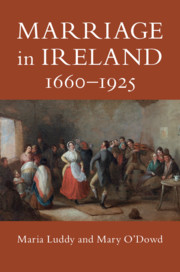Book contents
- Marriage in Ireland, 1660–1925
- Marriage in Ireland, 1660–1925
- Copyright page
- Dedication
- Contents
- Figures
- Illustrations
- Tables
- Acknowledgements
- Abbreviations
- Introduction
- Part I What Is a Marriage?
- Part II Ways to Marriage
- Part III Happy Ever After?
- Part IV The Unmaking of Marriage
- 10 Marital Violence
- 11 Desertion
- 12 Divorce
- Conclusion
- Select Bibliography
- Index
10 - Marital Violence
from Part IV - The Unmaking of Marriage
Published online by Cambridge University Press: 04 June 2020
- Marriage in Ireland, 1660–1925
- Marriage in Ireland, 1660–1925
- Copyright page
- Dedication
- Contents
- Figures
- Illustrations
- Tables
- Acknowledgements
- Abbreviations
- Introduction
- Part I What Is a Marriage?
- Part II Ways to Marriage
- Part III Happy Ever After?
- Part IV The Unmaking of Marriage
- 10 Marital Violence
- 11 Desertion
- 12 Divorce
- Conclusion
- Select Bibliography
- Index
Summary
This chapter explores the contexts of spousal violence, and considers the evolution of the legal discourses and judicial practices around this issue, and examines what this violence tells us about power, control and intimacy within marriages.It was widely believed in the nineteenth century that spousal assault was rare in Ireland, while it was thought to be a common practice in England.In the evolution of Irish national identity in post-Famine Ireland such beliefs distinguished the Irish from the English.Irish men were held to be morally superior to English men.But such beliefs were unfounded. More husbands abused and killed their wives, than wives did husbands. Husbands used their wives’ behaviour, their disobedience, intemperance, infidelity, lack of female virtue, inadequate fortunes, as excuses for causing a turn to violence or their wives’ deaths. Verbal and physical conflicts, could in the context of alcohol, spiral out of control. Money and property were also the causes of violence, as was the distribution of household resources.Some women feared the loss of their homes and other property and killed to protect their interests. Certain acts of violence were judged legitimate when particular contexts were taken into consideration.A drunken wife or a brutish and violent husband could, for example, see murder charges being reduced to manslaughter charges.
Keywords
- Type
- Chapter
- Information
- Marriage in Ireland, 1660–1925 , pp. 311 - 349Publisher: Cambridge University PressPrint publication year: 2020

